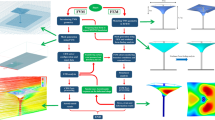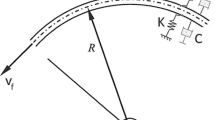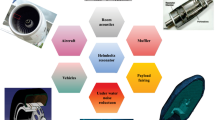Abstract
The most promising technology in the field of semi-active suspension systems is the use of magnetorheological property of MR fluid, whose material behavior can be controlled through external magnetic field. Devices developed based on this principle are adaptive and controllable as desired for a specific application. It is important to understand the damping characteristics of these devices before employing them, using experimental or computational approaches. In the present work, both experimental and computational methods have been adopted for characterizing a twin-tube MR damper with an intention to develop a computational approach as an alternative to experimental test in the preliminary design stage. Initially, experimental characterization of MR damper was carried out at 1.5 and 2 Hz frequencies for damper stroke length of ± 5 mm under different DC currents ranging from 0.1 to 0.4 A. Later, coupled finite-element and computational fluid dynamic analysis has been carried out to estimate the damping force under same conditions as used in the experiment. The results of computation are in good agreement with experimental ones. Furthermore, using this computational approach, the damping force at different frequencies of 1.5, 2, 3, and 4 Hz has been estimated and its time histories are also plotted. The influence of fluid flow gap on the damping force has been determined and results revealed that damping force behaves inversely with fluid flow gap.















Similar content being viewed by others
References
Rabinow J (1948) The magnetic fluid clutch. Am Inst Electr Eng Trans 67(2):1308–1315
Carlson JD (1999) Low-cost MR fluid sponge devices. J Intell Mater Syst Struct 10(8):589–594
Wang J, Meng G (2001) Magnetorheological fluid devices: principles, characteristics and applications in mechanical engineering. Proc Inst Mech Eng L 215(3):165–174
Wereley N (ed) (2013) Magnetorheology: advances and applications. RSC publishing, Cambridge, UK.
Spencer BF Jr, Dyke SJ, Sain MK, Carlson JD (1999) Phenomenological model for magnetorheological dampers. J Eng Mech 123(3):230
Dyke SJ, Spencer BF Jr, Sain MK, Carlson JD (1998) An experimental study of MR dampers for seismic protection. Smart Mater Struct 7(5):693
Spencer Jr BF, Yang G, Carlson JD, Sain MK (1998) Smart dampers for seismic protection of structures: a full-scale study. Presented at the Second World Conference on Structural Control, Kyoto, Japan, June 28–July 1 1998 (in press)
Yang G, Spencer BF Jr, Jung HJ, Carlson JD (2004) Dynamic modelling of large-scale magnetorheological damper systems for civil engineering applications. J Eng Mech 130(9):1107–1114
Mohammadi N, Kamalian N, Nasirshoaibi M (2017) High-frequency storage and loss moduli estimation for an electromagnetic rheological fluid using Fredholm integral equations of first kind and optimization methods. J Braz Soc Mech Sci Eng 39:2767
Bossis G, Lacis S, Meunier A, Volkova O (2002) Magnetorheological fluids. J Magn Magn Mater 252:224–228
Shams M, Ebrahimi R, Raoufi A, Jafari BJ (2007) CFD-FEA analysis of hydraulic shock absorber valve behavior. Int J Automot Technol 8(5):615–622
Parlak Z, Engin T (2012) Time-dependent CFD and quasi-static analysis of magnetorheological fluid dampers with experimental validation. Int J Mech Sci 64(1):22–31
Gurubasavaraju TM, Kumar H, Arun M (2017) Optimisation of monotube magnetorheological damper under shear mode. J Braz Soc Mech Sci Eng 39:2225
Samali B, Widjaja J, Li J, Reizes J (2003) Magneto-rheological shear dampers: quasi-static modelling and simulation. In: Proc. 10th Asia-Pacific vibration conf., pp 598–603
Chooi WW, Oyadiji SO (2008) Design, modelling and testing of magnetorheological (MR) dampers using analytical flow solutions. Comput Struct 86(3):473–482
Case D, Taheri B, Richer E (2016) Multiphysics modelling of magnetorheological dampers. Int J Multiphys 7(1):61–76
Omidbeygi F, Hashemabadi SH (2013) Exact solution and CFD simulation of magnetorheological fluid purely tangential flow within an eccentric annulus. Int J Mech Sci 75:26–33
Sternberg A, Zemp R, De la Llera JC (2014) Multiphysics behavior of a magneto-rheological damper and experimental validation. Eng Struct 69:194–205
Bompos DA, Nikolakopoulos PG (2011) CFD simulation of magnetorheological fluid journal bearings. Simul Model Pract Theory 19(4):1035–1060
Bullough WA, Ellam DJ, Wong AP, Tozer RC (2008) Computational fluid dynamics in the flow of ERF/MRF in control devices and of oil through piezo-hydraulic valves. Comput Struct 86(3):266–280
Zschunke F, Brunn PO, Steven M (2004) Simulation of a magnetorheological damper with a combination of a commercial CFD and FEA code. In: ASME/JSME 2004 pressure vessels and piping conference, pp 119–124
Gołdasz J (2015) Theoretical study of a twin-tube magnetorheological damper concept. J Theor Appl Mech 53(4):885–894
Wang D, Zi B, Qian S, Qian J (2017) Steady-state heat-flow coupling field of a high-power magnetorheological fluid clutch utilizing liquid cooling. J Fluid Mech. https://doi.org/10.1115/1.4037171
Gurubasavaraju TM, Kumar H, Arun M (2017) Evaluation of optimal parameters of MR fluids for damper application using particle swarm and response surface optimization. J Braz Soc Mech Sci Eng 39:3683
Sternberg A, Zemp R, De la Llera JC (2014) Multiphysics behavior of a magneto-rheological damper and experimental validation. Eng Structs 69:194–205
Han YM, Kim CJ, Choi SB (2008) A magnetorheological fluid-based multifunctional haptic device for vehicular instrument controls. Smart Mater Struct 18(1):015002
Anderson JD, Wendt J (1995) Computational fluid dynamics, vol 206. McGraw-Hill, New York
Sahin M (2003) Solution of the incompressible unsteady Navier–Stokes equations only in terms of the velocity components. Int J Comput Fluid Dyn 17(3):199–203
Arun M, Tulapurkara EG (2005) Computation of turbulent flow inside an enclosure with central partition. Prog Comut Fluid Dyn Int J 5(8):455–465
Menter FR (1992) Performance of popular turbulence model for attached and separated adverse pressure gradient flows. AIAA J 30(8):2066–2072
ANSYS CFX-solver theory guide, release 15.0 manual, November 2013. https://users.encs.concordia.ca/home/m/m_mamu/ANSYS%20CFX%20documentation/cfx_pre.pdf. Accessed 21 Jan 2017
Wereley NM, Pang L, Kamath GM (1998) Idealized hysteresis modelling of electrorheological and magnetorheological dampers. J Intell Mater Syst Struct 9(8):642–649
Susan-Resiga D (2009) A rheological model for magneto-rheological fluids. J Intell Mater Syst Struct 20(8):1001–1010
Zheng J, Li Z, Koo J, Wang J (2014) Magnetic circuit design and multiphysics analysis of a novel MR damper for applications under high velocity. Adv Mech Eng 6:402501
Snyder RA, Kamath GM, Wereley NM (2001) Characterization and analysis of magnetorheological damper behaviour under sinusoidal loading. AIAA J 39(7):1240–1253
Yang G, Spencer BF, Carlson JD, Sain MK (2002) Large-scale MR fluid dampers: modeling and dynamic performance considerations. Eng Struct 24(3):309–323
Xu ZD, Sha LF, Zhang XC, Ye HH (2013) Design, performance test and analysis on magnetorheological damper for earthquake mitigation. Struct Control Health 20(6):956–970
Jolly MR, Bender JW, Carlson JD (1999) Properties and applications of commercial magnetorheological fluids. J Intell Mater Syst Struct 10(1):5–13
Wang DH, Liao WH (2011) Magnetorheological fluid dampers: a review of parametric modelling. Smart Mater Struct 20(2):023001
Lord Corporation (2008) MRF-132DG magneto-rheological fluid, 2008. http://www.lordmrstore.com/_literature_231215/Data_Sheet_-_MRF-132DG_Magneto-Rheological_Fluid. Accessed 21 Jan 2017
Acknowledgements
The authors acknowledge IMPRINT Project No. IMPRINT/2016/7330 titled with “Development of Cost Effective Magnetorheological (MR) Fluid Damper in Two wheelers and Four Wheelers Automobile to Improve Ride Comfort and Stability” funded by Ministry of Human Resource Development and Ministry of Road Transfer and Highways, Govt. of India.
Author information
Authors and Affiliations
Corresponding author
Additional information
Technical Editor: Pedro Manuel Calas Lopes Pacheco.
Rights and permissions
About this article
Cite this article
Gurubasavaraju, T.M., Kumar, H. & Mahalingam, A. An approach for characterizing twin-tube shear-mode magnetorheological damper through coupled FE and CFD analysis. J Braz. Soc. Mech. Sci. Eng. 40, 139 (2018). https://doi.org/10.1007/s40430-018-1066-z
Received:
Accepted:
Published:
DOI: https://doi.org/10.1007/s40430-018-1066-z




